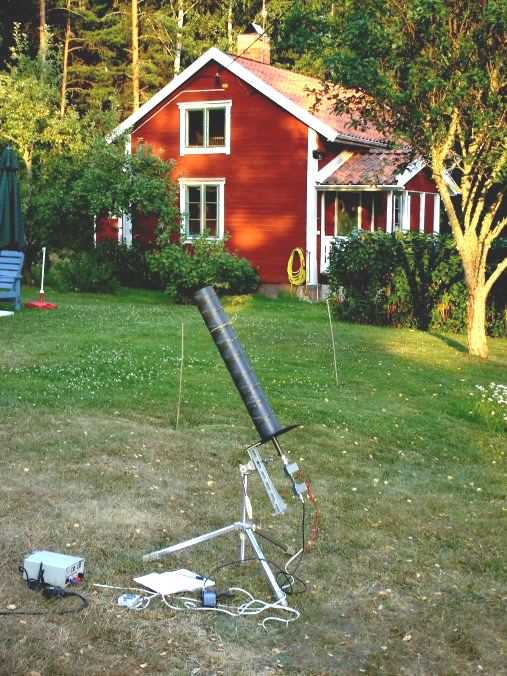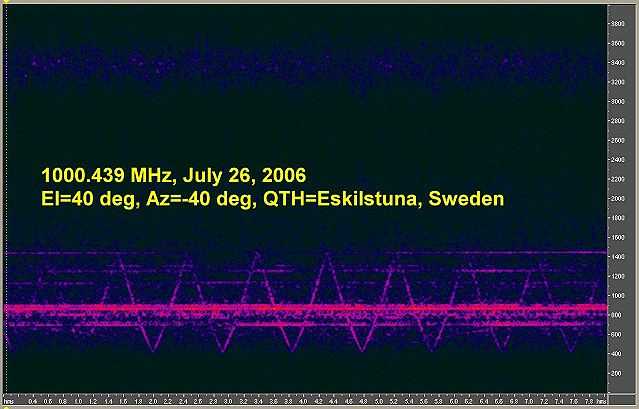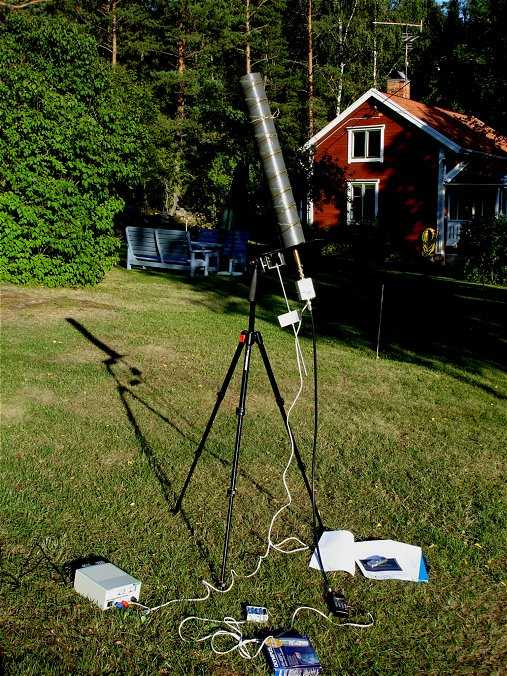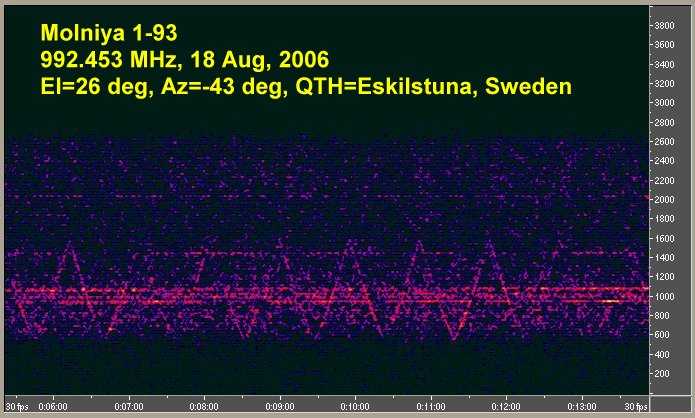

First
success 23 July, 2006
I was successful in picking
up signals from Molniya 1-90 at 1755-1830 UT on 23 July 2006 are a little
lower than Paul's measurements - see below. My signals were picked up on
the upleg and Paul's on the downleg, so the doppler could explain the difference.
N.B: my fx's are accurate to 2 kHz. It is hard to know when the signal
strength is maximum.
My fx
Paul's fx
------------------------
996.075....996.085
996.134....996.145
996.318....996.326
996.417....996.428
996.658....996.666 Very
strong
There may have been signals on the other frequencies, but I think Paul's setup is more sensitive than mine.
However, I picked up a strong CW signal on 992.4750 MHz. I moved the antenna around - it came from the same direction as the other signals, i.e. az near 60 degrees and elevation near 65 degrees.
Sweeping
carrier and off-the-air, 26 July, 2006
On July 26, 2006 I again
tried Molniya 1-90 on its Asian apogee, but I heard nothing in the 996-997
MHz range, but there were weak signals near 992.44 and 1000.44 MHz. I turned
the antenna and to my surprise found they came from a location in the sky
corresponding to the North American loop. As I turned the antenna the signal
strength increase significantly and I clearly hear several carriers and
the sweeping carrier near 992.44 and 1000.44 MHz. I used my cell phone
to record the sweeping carrier (listen to attached file and see spectrum
below). I then made the stupid mistake of sending the file from the cell
phone to my e-mail account while sitting near the antenna. I think
I blew out the preamp with the cell phone. So, it needs repair and puts
me off the air for quite a while on this fx. However, the sweeping carrier
recording is very nice and neat and so is the spectrum. I heard the TTC
signals between 1855-1900 UT (July 26). The sweep does not look entirely
symmetrical to me. The upper apex is more pointed than the lower apex,
isn't it? The sweep width is a few tens of Hz over 1000 Hz... This sweeping
signals reminds me of the stuff I picked up from Luna-20 more than 34 years
ago!
I have tried to identify which satellite it was, but my helix is quite broad in beamwidth... It is probably Molniya 1-93.
Sweeping signal wav-file
can be found here.
Spectrogram of sweeping
signal can be seen below.

Back
on the air, 18 August, 2006
On 16 August I got my new
pre-amp made by SSB Electronic in Germany. I had also bought a
better tripod for the antenna.

On 18 August I tried the
two satellites Molniya 1-90 and 1-93. Molniya 1-90 was on its Asian loop
and signals were much stronger than previously - perhaps caused by the
new pre-amp that has a noise figure of about 0.3 dB! The frequencies observed
at 1550-1620 UT were:
| 992.44 MHz | TTC signals, no sweeping carriers |
| 992.472 MHz | CW, very strong |
| 996.016 MHz | Digital modulation |
| 996.076 MHz | Digital modulation, very strong |
| 996.134 MHz | Digital modulation |
| 996.315 MHz | Digital modulation |
| 996.377 MHz | Digital modulation |
| 996.416 MHz | Digital modulation |
| 996.537 MHz | Digital modulation |
| 996.597 MHz | Digital modulation |
| 996.656 MHz | Digital modulation |
| 1000.44 MHz | TTC signals, no sweeping carriers |
The slant range during this reception was about 38500 km. I then swung the antenna to the North American loop of Molniya 1-93 at 1625-1635 UT, 45 minutes after it had broken my horizon. The TTC signals on 1000.455 MHz and 992.453 MHz were there, but weak, despite a slant range of only 25000 km. There was a weak sweeping carrier on 992.45 MHz, see figure below. This looks identical to the type of sweeps observed before.

The
first person to track Molniya-1 satellites
The first person to track
Molniya-1 satellites was Steve Birkill. In "Soviet Space programs:
1976-80" Senate print 98-235, May 1985, Chapter 4, Annex 1 we can read:
Channel frequencies and utilization in the Soviet communications satellite systems, with particular reference to the television traffic:
".... observations at Sheffield, England, since 1976 have revealed the presence of signals between 974 and 998 MHz approximately, suggesting a transponder bandwidth on the order of 30 MHz, adequate for FM television, extending perhaps from 970 to 1000 MHz...
"...Current usage of this UHF channel [Molniya-1] is divided between two independent used sets of Molniya-1 satellites. The four active spacecraft falling into the standard orbital plane groupings A through D carry a series of FM carriers, some of which are frequency-division multiplexed (FDM) between 974 and 985 MHz approximately, for 3 hours each side of apogee on the Asian loop of the orbit, over the Soviet Union. They are also used in their North American loop, over Canada, though with fewer carriers, also grouped around 980 MHz.
The second set of four satellites, those with their orbital planes intermediate between the four standard groups, appears to operate only on the Asian loop, and carries an estimated 12,5 kilobits per second digital frequency-shift keyed (FSK) signal of 140 kHz deviation, close to 998 MHz. No detailed analysis of modulation parameters or information content of these signals has been attempted.
The Molniya-1 satellites are dual-fed at changeover, the "incoming" and "outgoing" spacecraft simultaneously carrying the same traffic for a period of up to 5 minutes....."
The information was provided by Steve Birkill. Steve has his own web site.